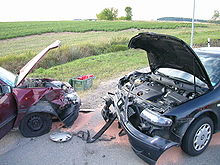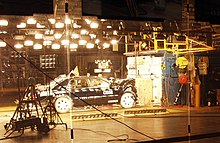Crumple zone: Difference between revisions
m Reverting possible vandalism by 76.26.188.173 to version by 86.27.163.238. False positive? Report it. Thanks, User:ClueBot. (370949) (Bot) |
No edit summary |
||
| Line 4: | Line 4: | ||
[[Image:Vehicle crash test at the General Motors Vehicle Safety and crash Worthiness Laboratory.jpg|thumb|right|A [[crash test]] illustrates how a crumple zone absorbs energy from a crash.]] |
[[Image:Vehicle crash test at the General Motors Vehicle Safety and crash Worthiness Laboratory.jpg|thumb|right|A [[crash test]] illustrates how a crumple zone absorbs energy from a crash.]] |
||
The '''crumple zone''' of a |
The '''crumple zone''' of a vehic such as a [[train]] or an [[automobile]] is a structural feature designed to compress during an [[accident]] to absorb [[energy]] from an impact. Typically, crumple zones are located in the front part of the vehicle, in order to absorb the impact of a [[head-on collision]], though they may be found on other parts of the vehicle as well. |
||
The crumple zone concept was used by the [[Mercedes-Benz]] engineer [[Béla Barényi]] on the 1959 [[Mercedes-Benz Heckflosse|Mercedes-Benz ''"Fintail"'']].<ref>[http://motoring.independent.co.uk/features/article340543.ece]</ref> |
The crumple zone concept was used by the [[Mercedes-Benz]] engineer [[Béla Barényi]] on the 1959 [[Mercedes-Benz Heckflosse|Mercedes-Benz ''"Fintail"'']].<ref>[http://motoring.independent.co.uk/features/article340543.ece]</ref> |
||
Revision as of 07:24, 13 May 2008




The crumple zone of a vehic such as a train or an automobile is a structural feature designed to compress during an accident to absorb energy from an impact. Typically, crumple zones are located in the front part of the vehicle, in order to absorb the impact of a head-on collision, though they may be found on other parts of the vehicle as well.
The crumple zone concept was used by the Mercedes-Benz engineer Béla Barényi on the 1959 Mercedes-Benz "Fintail".[1]
Function
Crumple zones work by managing the crash energy so that it is absorbed within the frontal section of the vehicle (energy is transformed by the deformation instead of being directly transmitted through the body of the occupants), while also preventing intrusion into or deformation of the passenger cabin. This acts to ensure that car occupants are better protected against injury. In simplistic terms, this is done by controlled weakening of outer parts of the car while strengthening the inner (passenger cabin) part of the body by using more reinforcing beams and increasingly, higher strength steels.
A common misconception about crumple zones is that they reduce safety by allowing the vehicle's body to collapse, crushing the occupants. In fact, crumple zones are located in front and behind of the main body of the car, compacting within the space of the engine compartment or boot. The marked improvement over the past two decades in high speed crash test results and real-life accidents also belies any such fears. Modern vehicles using what are commonly termed 'crumple zones' provide, on average, far superior protection for their occupants in severe tests than older models.
The only other general downside to crumple zones is that repair costs are higher in "fender bender" accidents.
The 2004 Pininfarina Nido Experimental Safety Vehicle locates crumple zones inside the Survival Cell. Those interior crumple zones decelerate a sled-mounted survival cell.[2]
See also
References
External links
crumple zones can save lives
